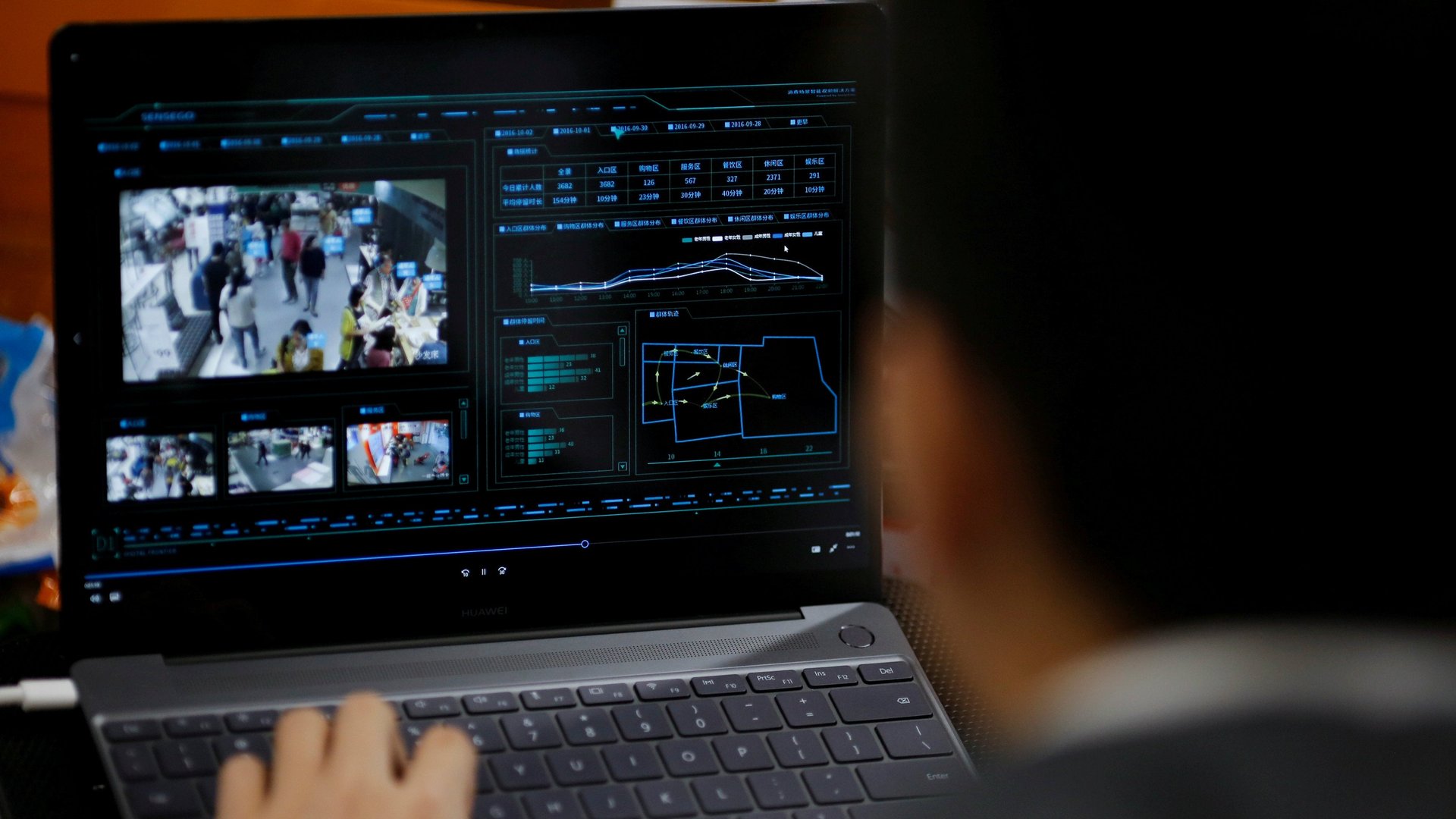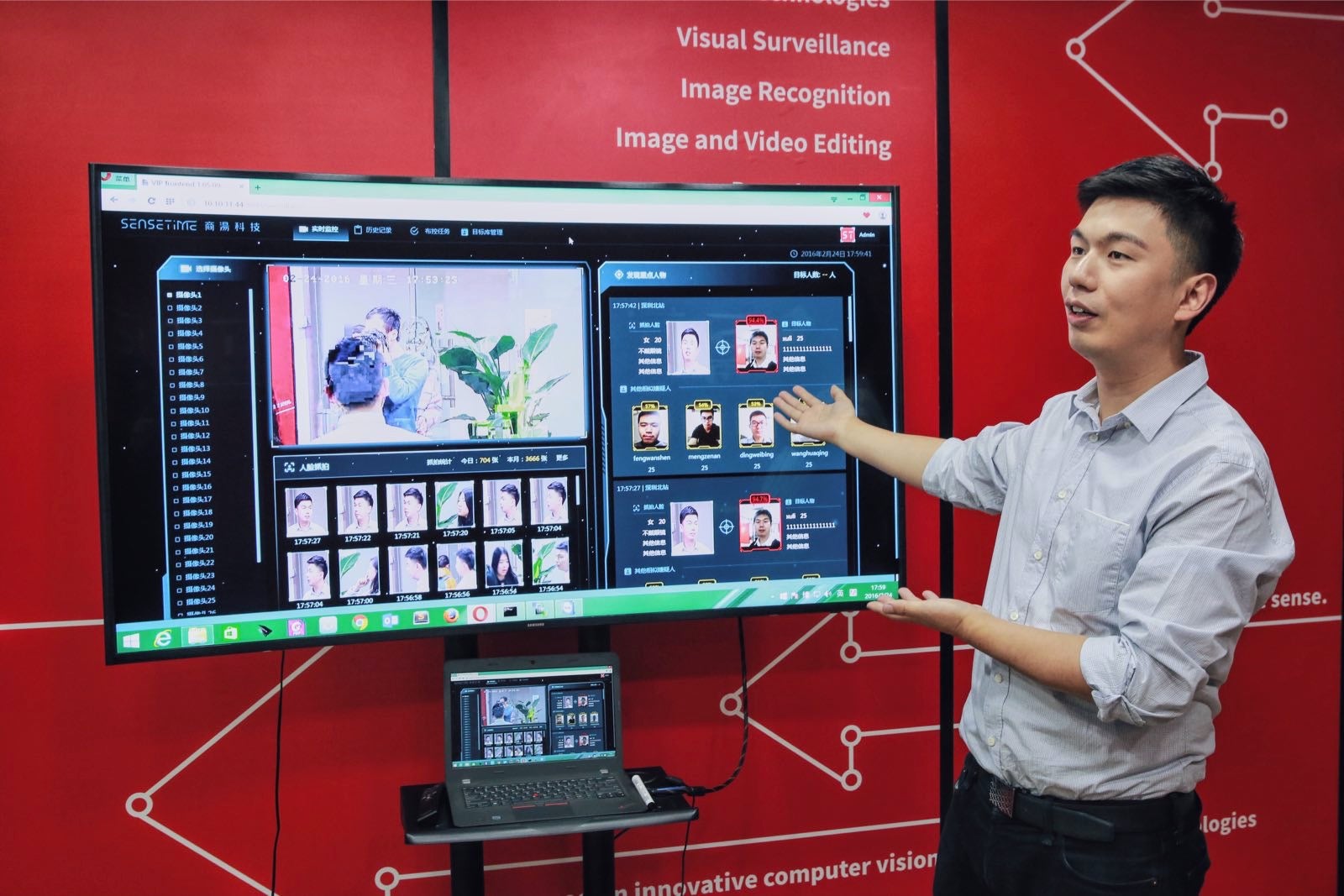The billion-dollar, Alibaba-backed AI company that’s quietly watching people in China
Most Chinese consumers have likely never heard of SenseTime. But depending on where they live, it might be looking at their faces several times a day.


Most Chinese consumers have likely never heard of SenseTime. But depending on where they live, it might be looking at their faces several times a day.
If a person goes shopping at Suning, one of China’s largest electronics retailers, it’s possible that a camera in the store is tracking her behavior using SenseTime’s software. Later, if she opens Rong360, a peer-to-peer lending app, she’ll be asked to login using facial recognition—powered by SenseTime. She might send a video of herself to her friends on SNOW, a Snapchat-esque chat app, donning animated sunglasses built by SenseTime. And if she finds herself approached by police officers in the subway, it’s possible SenseTime helped identify her.
SenseTime is one of a handful of companies at the forefront of China’s artificial intelligence (AI) boom, which is heavily supported by a government that has vowed to turn AI into a $150 billion industry by 2030. Founded in Hong Kong, the company has hundreds of customers from around the world and counts on investors like US chip designer Qualcomm and Chinese real estate developer Dalian Wanda. Last week e-commerce giant Alibaba announced it led a $600 million investment round into SenseTime, taking the AI firm’s valuation to about $3 billion.
Few companies, if any at all, in the United States have reached billion-dollar valuations solely on the back of facial and image recognition. SenseTime’s rapid journey to becoming one of the world’s most valuable AI startups highlights how factors unique to China have facilitated a surge in artificial intelligence-backed recognition that’s still in the early stages.
“China is really moving ahead, especially in video and image understanding, because we have the real world problems, we have the real world data, and we also have a stronger talent pool dedicated to those kinds of things,” SenseTime CEO Xu Li tells Quartz.
Watching people, in every industry
SenseTime was founded in October 2014 by Prof. Tang Xiaoou, chair of the information engineering department of the Chinese University of Hong Kong, along with 11 students researching computer vision and deep learning. While it originated as an academic project, the team revamped itself as a business in 2015 with the appointment of Xu, one of Tang’s proteges, as CEO. After spending its first year as a company focusing on research and development, it began launching products in 2016. It now says it has over 400 customers.

Most consumers, when they think of “facial recognition in China,” likely think of surveillance. But SenseTime offers a range of different software products to its clients. Some of these are directly related to surveillance—it offers software to police bureaus to help them identify live faces, crowd movement, car license plate numbers, and vehicle types. At least one prison uses SenseTime’s software to assist with security. But SenseTime also offers software to private companies, including apps like microblog Weibo and handset makers like Oppo, to improve photo-sorting and image editing around a face. It also works with retailers looking to harvest real-time analytics about how different types of customers use the store. Apart from electronics retailer Suning, Xu says the company has run pilots with some Walmart outlets in China. (Walmart said it doesn’t comment on vendor relationships.)
Xu says that SenseTime’s first boon as a business arrived when a surge of peer-to-peer lending apps hit the market in China. Throughout 2016, a number of Chinese tech companies emerged that let individuals crowdsource loans to and from other people. In order to reduce identity fraud, many companies turned to SenseTime and similar AI companies to match a person’s “live” face against the one on their government-issued ID. Ordinarily, Xu says, this verification would have required human labor.
In Xu’s view, the maturation of facial-recognition technology and the emergence of peer-to-peer lending apps marks an important convergence—and an example of one advantage China has over the US and other countries. Online peer-to-peer lending became popular in China in the first place because China, unlike the US, lacks a developed consumer banking and finance industry. SenseTime’s facial recognition software, as a result, had an immediate use-case scenario that companies and customers were eager for.
“I see that in China, there is really a slight advantage in developing AI. Because we usually have a customer need,” says Xu. “You know, in the US, there may be one Lending Club,” he adds, referring to the best-known US-based online peer-to-peer lending company. “But in China, at the time, there were thousands of Lending Clubs.”
Xu points to two other phenomena in China’s tech industry that have helped hasten the spread of facial recognition technology. First, the rise in “long-tail” Chinese smartphone brands looking to differentiate themselves with facial logins or gimmicky camera apps that enhance one’s appearance gave SenseTime a handful of clients. Outside of China, in contrast, there are only a few foreign handset brands still competing fiercely for market share.
Second, and more importantly, the demand for upgraded surveillance technology across China has turned government-affiliated security bureaus into eager SenseTime customers. China currently has about 176 million surveillance cameras deployed domestically—and that figure has increased at an average of 13% annually between 2012 and 2017, compared with the global growth rate of 2%, according to research firm IHS. China is expected to account for 46% of global surveillance equipment revenues this year, the research firm has said. SenseTime, naturally, benefits from this demand. The company has partnered with security bureaus in Guangzhou, Shenzhen, and Yunnan province, providing its software to police who use it to identify criminals in public places and provide leads from crime scene footage.
Xu says that 30% of SenseTime’s clients are “government-related.” Two individuals—Jeffrey Ding, who researches AI in China at Oxford University, and a SenseTime partner in Southeast Asia who requested anonymity—say that figure is likely much higher. “The majority of people buying these services from these Chinese startups are, I think, in the public security sector,” says Ding.
China isn’t just leading the world in purchasing surveillance cameras, it’s running various experiments that use facial-recognition technology to track citizen movements in unprecedented detail. Edward Schwarck, a visiting research fellow at the Japan Institute of International Affairs, notes in new research (registration required) that in the last two decades China’s Ministry of Public Security has re-envisioned itself as a large-scale information management agency to better control “an increasingly fluid, networked, and technologically sophisticated society.” As part of that, the ministry’s Golden Shield project pooled data that might have once been siloed in local security bureaus. “Arguably, the most significant change is in how the system is likely to evolve in the future,” writes Schwarck. “The consolidation of public security databases has created space for data-hungry artificial intelligence platforms that will allow the automation of a greater array of policing functions.”
This in part explains why SenseTime and its two Chinese rivals, Megvii and Yitu, each have billion-dollar-plus valuations, while no US-based startups specializing solely in facial recognition have reached similar heights.
“I don’t think there are many states or cities in the US that are looking to implement a very pervasive facial-recognition-based system,” Ding adds.
Deep in data
Apart from being a customer, China’s government has also played a pivotal role in helping SenseTime, Xu explains, by providing it access to data. SenseTime claims to have a training database of over 2 billion images—many publicly available training databases top out at 10 million images. According to Xu, at least some of this data comes from various government agencies, which provide it to SenseTime to help the company train its algorithms. For example, Xu says that it’s working with a branch of the Shenzhen government to train its algorithms against the city’s existing recorded video surveillance footage—though he says that any information directly linking a face to a personal ID is off limits, and that SenseTime cannot “extract” this data for its own use internally.
Data is the foundation for building algorithms that power machine learning tools. Many of the advances in artificial intelligence worldwide stemmed from ImageNet, a public database that now consists of more than 13 million images that companies from all over the world have used to train their image-recognition capabilities. In China though, government bureaus at various levels collect an extraordinary amount of data.
“The government has the largest data set,” he explains. “If you have access to the government data, you have all the data from all Chinese people, all the data from BAT [Baidu, Alibaba, and Tencent, China’s three main internet giants]… you have almost all the data in the world,” he says, exaggerating. He adds, “More importantly, the original data has been encrypted, which means nobody can do reverse engineering to recover the original data.”
Chwee Kan Chua, who follows China’s AI industry at research firm IDC, admits that politics likely plays a role in SenseTime’s early success. But he argues that since AI algorithms get better with more exposure to more data, SenseTime and other Chinese image-recognition companies are by now ahead of their foreign peers.
“In China, most of the Chinese customers are all using local Chinese companies,” he says. “Simply because they have better algorithms right now compared to the rest of the world.” SenseTime has won awards to back this up. In 2015, the company beat Google and other high-profile tech companies in the ImageNet Large Scale Visual Recognition Challenge (ILSVRC), a major industry competition, in a challenge testing for identifying objects in videos. In addition, since facial recognition-software can vary in accuracy depending on the gender or racial composition of a database, software trained in part on local data may be more accurate in complex identification situations in China.
While proponents of some degree of civilian monitoring can improve public security, some worry that authorities in China will use artificial intelligence to take surveillance to unprecedented levels. The most extreme example of that, experts say, can be seen in China’s Xinjiang region, where more than half the population belongs to the Muslim Uighur community. Authorities have deployed facial recognition, biometrics collection, internet monitoring software, and other tools to restrict the movement and behavior of Uighurs, ostensibly to prevent radicalization. Some say Xinjiang may also be a testing ground for a nationwide push of some of these surveillance methods.
In other parts of the world, the use of facial recognition for consumer purposes, let alone surveillance, has been much more restricted over rights concerns. In Europe, for example, a new law coming into effect next month will require explicit consent to process biometric data that can be used to identify a person, and large-scale uses will require companies to carry out privacy impact assessments first.
When asked about facial recognition’s potential to be used by governments to curtail human rights and invade privacy, Xu compares artificial intelligence to the industrial revolution, noting that AI can be used both for bad and good causes.
“We are actually trying to do things that will help people,” Xu says. “For example, facial-recognition technologies can also help prevent missing children. If you apply surveillance cameras in that way, it can really help the general public.”
That may be a harder sell overseas, where the company is slowly expanding its presence. Earlier this year SenseTime joined MIT’s Intelligence Quest, an initiative that brings together experts from different disciplines to advance AI across a range of fields. The company has offices in Singapore and in Japan, where it has a partnership with Japanese auto maker Honda to develop technology for autonomous vehicles.
But abroad, SenseTime will be operating without the state support it has enjoyed domestically, and with a lot more public scrutiny about privacy and surveillance. In China, SenseTime can count on governments buying its software and giving it access to data; elsewhere, new markets might require new tactics.